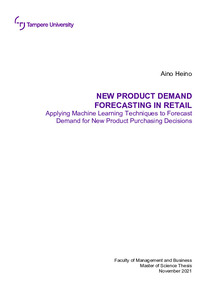New Product Demand Forecasting in Retail : Applying Machine Learning Techniques to Forecast Demand for New Product Purchasing Decisions
Heino, Aino (2021)
Heino, Aino
2021
Tuotantotalouden DI-ohjelma - Master's Programme in Industrial Engineering and Management
Johtamisen ja talouden tiedekunta - Faculty of Management and Business
This publication is copyrighted. You may download, display and print it for Your own personal use. Commercial use is prohibited.
Hyväksymispäivämäärä
2021-12-08
Julkaisun pysyvä osoite on
https://urn.fi/URN:NBN:fi:tuni-202112068926
https://urn.fi/URN:NBN:fi:tuni-202112068926
Tiivistelmä
In retail, it’s vital to minimize food spoilage and working capital, and to maximize product availability and sales. To make it possible, retailers must know what the proper order quantity is when making purchase decisions. Hence, demand forecasting plays a crucial role in retail industry. However, generating accurate forecasts is difficult, especially when it comes to new products for which there is no historical data available. In addition, the most common new product forecast methods are at least partly judgemental and thus inefficient. Consequently, there is a clear need for accurate and efficient method for forecasting new product demand.
This thesis addresses the phenomena by applying and evaluating five machine learning models for new product demand forecasting for purchase decisions in retail and selecting the model that performs best. The forecasting problem is formulated as a classification task in which the objective is to forecast the magnitude of sales for new products. The applied machine learning models are 1) logistic regression, 2) support vector classification, 3) nearest neighbors, 4) XGBoost, and 5) multi-layer perceptron. For applying the models, a machine learning work-flow is designed. In the workflow, suitable features are formulated by converting raw data into desired variables and selecting the final features through a systematic process. The features are scaled using three different methods, and the best performing method is selected for each model. In addition, hyperparameters are tuned through cross-validation. The evaluation and model selection are based on accuracies, precision, recalls, and F1-scores of the models, and the sensitivity to random states is considered. The utilized data set is provided by a case company, which is an e-commerce retailer that focuses on surplus products.
The results show that all the five models perform better than the benchmark model, which predicts the major class among training samples for all the test samples. The performance metrics of the models don’t depend significantly on different random states. The selected model for forecasting new product demand in the case company is the XGBoost model, which overperforms the other applied models in all the evaluation metrics. The XGBoost model is ready for implementation in the case company since the model is already optimized using the data from the company. The developed new method is robust and efficient, and it eliminates many problems related to the current method the case company uses. Even though the models must be optimized again if the models are used in other contexts, this study introduces a machine learning workflow that provides tools for that, and the workflow is easy to follow. This study proves that new product demand can be forecasted successfully using machine learning classification methods, which is an interesting alternative approach to more traditional regression methods. As a suggestion for future research, the models could be developed further and optimized separately for different product types. Moreover, in addition to demand forecasting, applying classification models to classify other product characteristics could be considered.
This thesis addresses the phenomena by applying and evaluating five machine learning models for new product demand forecasting for purchase decisions in retail and selecting the model that performs best. The forecasting problem is formulated as a classification task in which the objective is to forecast the magnitude of sales for new products. The applied machine learning models are 1) logistic regression, 2) support vector classification, 3) nearest neighbors, 4) XGBoost, and 5) multi-layer perceptron. For applying the models, a machine learning work-flow is designed. In the workflow, suitable features are formulated by converting raw data into desired variables and selecting the final features through a systematic process. The features are scaled using three different methods, and the best performing method is selected for each model. In addition, hyperparameters are tuned through cross-validation. The evaluation and model selection are based on accuracies, precision, recalls, and F1-scores of the models, and the sensitivity to random states is considered. The utilized data set is provided by a case company, which is an e-commerce retailer that focuses on surplus products.
The results show that all the five models perform better than the benchmark model, which predicts the major class among training samples for all the test samples. The performance metrics of the models don’t depend significantly on different random states. The selected model for forecasting new product demand in the case company is the XGBoost model, which overperforms the other applied models in all the evaluation metrics. The XGBoost model is ready for implementation in the case company since the model is already optimized using the data from the company. The developed new method is robust and efficient, and it eliminates many problems related to the current method the case company uses. Even though the models must be optimized again if the models are used in other contexts, this study introduces a machine learning workflow that provides tools for that, and the workflow is easy to follow. This study proves that new product demand can be forecasted successfully using machine learning classification methods, which is an interesting alternative approach to more traditional regression methods. As a suggestion for future research, the models could be developed further and optimized separately for different product types. Moreover, in addition to demand forecasting, applying classification models to classify other product characteristics could be considered.
